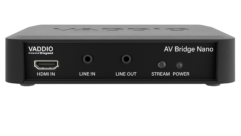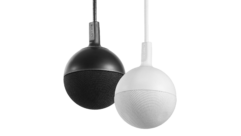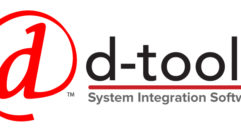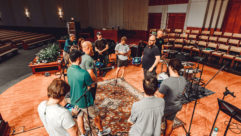InfoComm 2003
Jul 1, 2003 12:00 PM,
S&VC Staff
The 2003 edition of the InfoComm Show held in Orlando, Florida, was all the things that the regular attendees and exhibitors of the show have come to expect over the years. “We’re delighted with the reactions we’ve heard from both exhibitors and attendees to InfoComm ’03,” says Randal Lemke, PhD, executive director of ICIA/InfoComm. “Attendance at the show was very healthy at 19,761, almost matching last year’s despite a tough economic environment and other world events.”
Hot topics of the show continued to be IP networking, streaming media, and videoconferencing. The theme of the show was “Evolving the Art of Communication,” and the buzzword was convergence: convergence of art and technology, convergence of A/V and IT, and even the convergence of trade organizations. At a press conference held on June 2, the management of ICIA/InfoComm, NSCA, and CEDIA announced they have formed a partnership to develop and produce joint trade exhibitions in Europe, China, and Asia. The Streaming Media Pavilion sponsored by Sound & Video Contractor, SRO, and Video Systems magazines in conjunction with ICIA and iShow provided a forum for showcasing streaming technology as a growing communication and presentation tool.
Of note were the educational and training sessions offered this year. Exceeding last year’s registration, educational sessions were well attended with more than 5,000 people taking advantage of the workshops, seminars, and manufacturers training sessions. InfoComm’s audio focus included a first-time offering of a Syn-Aud-Con course that drew a steady crowd of integrators for three full days of training.
The exhibit floor activity was fairly constant throughout the three days of the show. Reaction from the show floor from both exhibitors and attendees was generally upbeat and positive. “Overall, I thought it was a good show,” says Derick Hill, director of operations of Clark ProMedia and a systems integrator from Cumming, Georgia. “There seemed to be a good mix of manufacturers represented.” Booth traffic was generally busy but not overwhelming. Following are some of the highlights from the exhibit floor:
PRESENTATION, CONFERENCE SYSTEMS, INTERFACES, AND ANCILLARY EQUIPMENT
Advanced Media Design introduced MediaPointe System One and System Two conferencing systems, which allow any media source or combination of sources to be displayed by the operator on a full screen, in multiple windows on the screen, or on multiple screens. Polycom‘s ViewStation EX is the latest addition to its line of set-top videoconferencing systems.
Hitachi‘s Interactive Communications Group introduced the StarTablet T-18SX. The StarTablet is an interactive 18-inch TFT device with SXGA-quality graphics. The StarTablet permits presenters to run and annotate computer applications while simultaneously displaying the annotated images on rear-projection or plasma displays or traditional screens using LCD projectors.
Smart Technologies introduced the Rear Projection SMART Board 2000i interactive white board. The 2000i ships with an SVGA (800 by 600), 1,600-lumens projector with an option to upgrade to an XGA (1,024 by 1,280), 2,500-lumen projector.
IMatte launched iSkia (Greek for “the shadow”). ISkia generates a mask to selectively inhibit the projected image. It allows the image to be projected on the screen but not on the presenter or in the presenter’s eyes.
Intelix introduced Event Scheduling software for Intelix M Series E audio/video matrix mixers. The software works in conjunction with Intelix M Series Designer software.
Christie debuted ChristieNet projector management and control solutions enabling the ability to connect any Christie projector to any windows-based network, allowing A/V control and monitoring anywhere around the world. Electrosonic showed the Director, a network-enabled display processor designed to access, manage, control, and display multimedia information sources. Crestron introduced a new product range, dubbed Crestron Media Manager. The line is a combination of technologies designed to integrate A/V device control, facility-wide management, signal switching, and routing in a single family of products.
Omnimount Systems introduced two new Universal Projector Mounts, the PMD-1 for small DLP projectors and the PMD-2 for larger LCD projectors. Middle Atlantic Products introduced its custom LCD rackmount system, which is available with anodized or textured finishes. The LCD mounts can accommodate most monitors up to 17 inches in diagonal size.
Folsom Research showed its ScreenShaper video-mapping system, which allows curved screen panoramic projection for immersive environments. Similar software was seen in other booths, though it wasn’t as powerful as the Folsom demo.
Extron rolled out its IP Link line of interfaces during the show. These boxes provide IP to RS-232C conversion and can be used with any A/V equipment that employs an RS-232C interface. On the test equipment front, the VTG-300 is a complete overhaul of the older VTG200 and offers 31 video output rates and numerous test patterns — and it’s battery powered.
Vista Systems had a nice demo of its Montage multichannel seamless video mixing/switching system. It can handle as many as 12 overlaid channels and also transition between seamless panoramic video and graphics. Silicon Optix showed a brand-new video scaler that incorporates its image-reshaping technology for off-axis projection.
Kramer somehow figured a way to make an even lower-cost video scaler, the VP-719DS. It accepts everything from VGA to UXGA (even DVI) and converts to five PC and six nonstandard display rates to best match fixed-pixel imagers.
Astro Systems announced a new portable video signal test generator, the VG-848. It can crank out signals to QXGA (2,048 by 1,536), test HDCP, and support component, composite, and DVI interfaces. Gefen showed a clever system of building-block DVI distribution amplifiers (who says you can’t split DVI?).
Analog Way displayed the new Octo-Logo. It’s a high-resolution logo inserter and seamless switcher for conference rooms and boardrooms. As many as eight logos can be stored in memory, and each logo can be positioned anywhere on the screen and distributed to any of the eight universal inputs as a matte image or keyed over another image.
AUDIO
Shure offered an early look at its new ConferenceOne Discussion Systems that combines microphones, automatic mixing, and loudspeakers into one public-address system. It’s scheduled to ship this summer.
Digigram showed for the first time the Audio Manager, a set of software tools for local and remote supervision of multizone-networked audio. The system includes software components for system design, configuration, and monitoring; automated scheduling of audio events; live announcements, recording of audio for later playback; and networked storage of recorded audio.
TOA introduced the NX-100 network audio adapter, a hardware codec that converts analog audio signals to TCP/IP-based Ethernet format for transport and routing over existing local and wide area networks, including the Internet.
Martin Audio exhibited the W8LC compact three-way, all-horn line array. Sound-pressure level (SPL) is up to 106 dB at 1W/1m. Meyer Sound featured the MILO high-power curvilinear array loudspeaker. The four-way system produces a peak output of 140 dB SPL. The operating frequency range is 60 Hz to 18 kHz. Tannoy is shipping the CMS60 TDC B ceiling monitor system featuring a 6.5-inch point source, constant directivity Dual Concentric transducer. Turbosound is shipping the self-powered, two-way Qlight Series TQ-308SP loudspeaker enclosure. The loudspeaker features a rotatable 100 degrees horizontal by 60 degrees vertical Converging Elliptical Waveguide design allowing for both vertical and horizontal orientation.
Telex/RTS introduced the RTS Cronus digital matrix intercom. Cronus features utilization of LAN and USB connectivity for programming.
Stardraw‘s Weblink allows manufacturers to embed custom data within the symbols that represent their products in Stardraw’s database.
Audio-Technica showed its new Engineered Sound products, the ES991 dual-element cardioid condenser gooseneck and ES993 and ES995 dual-element cardioid condenser rigid-pipe microphones. DPA launched the 4067 adjustable miniature headband mic, which features a new preamp that will broaden its compatibility across a wider range of wireless system brands.
Sabine is shipping its 2.4 GHz True Mobility wireless microphone systems. The receivers are available in 1- and 2-channel models and come with built-in processing that includes the FBX Feedback Exterminator.
Sennheiser introduced the InnovaSon Sy80, which features 80 inputs, 80 outputs, 80 faders, and 48 mix buses housed in a chassis weighing less than 176 pounds. New software allows users to define the function of every fader on the console surface.
XTA showed the DP6i audio installation controller designed for applications in the installed-sound market. The unit features two inputs and six outputs. Both inputs have an 8-band parametric equalizer, base delay, and gain control. All outputs feature crossover filters, 5-band parametric equalizer, high- and low-shelving filters, limiter, and delay.
QSC Audio Products introduced QSControl.net, which encompasses integration of signal transport, control, processing, and monitoring technologies. The first hardware product, the Basis 922az, features configurable digital signal processing and CobraNet audio transport. The unit has eight analog line level inputs and four stereo (eight channels) QSC DataPort outputs.
Yorkville Sound introduced the Coliseum CA1 and CA1T 70V public-address amplifiers designed specifically for paging systems with music playback. The amplifiers feature XLR/TRS balanced combijack and RCA inputs for microphone or source material, and voice-activated paging from either a microphone or a telephone matrix.
PROJECTORS
InFocus rolled out the LP120 personal projector. This tiny XGA (1,024 by 768) DLP design weighs just 2 pounds (1.98 pounds, to be exact) and looks like a small brick with a lens at one end. In addition, there’s a Proxima version, the DP1200x, with the same specs. Proxima also has a new desktop/installation projector, the Proxima DP8200x (1,024 by 768, 3,000 lumens), and (of course) there’s an InFocus version of it, the LP820.
Sanyo, as usual, brought along a truckload of new projectors (most of them IP ready with Sanyo’s PJ Net Organizer software). In the ultraportable arena, there’s the PLC-XU50/55 (1,024 by 768, 2,000/2,500 lumens) and the PLC-SU55 (SVGA, 2,000 lumens).
Digital Projection had its new Mercury DLP projector (1,024 by 768, 4,500 lumens) on display. This three-chip DLP design is much more compact than traditional xenon-lamped large-venue projectors and is aimed at the conference room market that is now dominated by LCD technology.
BenQ placed a few new DLP projectors out for viewing, including the 1,700-lumens PB2220 (1,024 by 768), the PB7220 (2,500 lumens, 1,024 by 768), and the “combo” home-theater/office PB8230 (1,024 by 768, 2,500 lumens). Next-door competitor Optoma made news with its H76 home-theater projector. It uses a single 1,280-by-720 DMD with color wheel and is rated at 1,000 lumens.
Sony upped the ante with two new SuperLite LCD projectors, the VPL-CS6 (800 by 600, 1,800 lumens) and the VPL-CX6 (1,024 by 768, 1,500 lumens). Both models weigh just over 5 pounds. A new network projector comes to the line in the VPL-PX35 (1,024 by 768, 2,600 lumens).
Toshiba was one of those manufacturers that opted to stay off the show floor and exhibit across the street at the Peabody Hotel. In its suite were the new TLP-720/721 LCD projectors (1,024 by 768, 2,400 lumens, document camera on 721) with integrated 802.11b wireless connectivity.
NEC was all over the place with its projector intros. The eye-catching WT600 is a supershort throw single-chip DLP design that can fill up a 100-inch 3-by-3 screen from as little as 26 inches distant. It uses 1,024-by-768 DMDs and is rated at 1,500 lumens. Need to copy a document to the screen? The DT20 can do it as well as show 3-D objects from its scanner, using 1,024-by-768 LCD panels and 2,800 lumens brightness.
Panasonic used InfoComm to debut the PT-LC80U, a 4.6-pound 1,024-by-768 LCD design with a quick (1.5 second) auto-setup mode, 2,000 lumens, and antitheft features like panel lockout and text superimposition over any image (important for the education market). In the ultraportable space, you’ll find the PT-L735NTU (1,024 by 768, 2,600 lumens, networking features) and the PT-L735U (same, except no networking). Both weigh just less than 10 pounds.
Barco has come out with a new performer, the RLM G5. It’s intended for the staging and rental market and uses three-chip DLP imaging with 4,500 lumens. More importantly, it also employs the Mercury XGA DMD engine with dual UHP lamps and weighs only 55 pounds. Sharp announced one new projector, the PG-A20X (2,000 lumens, 1,024 by 768, 6.4 pounds) and upgraded another, the XG-C55X (3,000 lumens, 1,024 by 768, 11.2 pounds).
Mitsubishi is another strong player in the education market, and many of its 2003 offerings include security features, too. Of interest were the XL5950 ColorView (1,024 by 768, 4,700 lumens) installation LCD projector, the XD350 ColorView (1,024 by 768, 2,500 lumens) DLP chassis, and the tiny XD50U Mini-Mits (1,024 by 768, 1,500 lumens) DLP microportable.
Samsung apparently could not resist the lure of home theater and showcased the SP-H700AE front DLP projector.
FLAT SCREENS
NEC-Mitsubishi took the wraps off a 40-inch TFT LCD monitor called the LCD4000. First announced in February, this 1,280-by-728 design brings another major player into the rapidly growing big-screen LCD market and puts more pressure on plasma. Sharp showed the LC-M3700, a 37-inch LCD monitor with 1,366-by-768 resolution and wide viewing angles that is adapted from its consumer TV offering.
Mitsubishi finally got its superthin, 10-inch-deep VS-60XT2OU MegaView DLP projection cube to market. This design measures 60 inches diagonally and has XGA (1,024 by 768) resolution. Orion showed the NeoDigm, a tiled 84-inch plasma made up of four 853-by-480 plasma display panels. Given that NEC also has an 84-inch plasma with the same approach, this is likely an OEM product looking for a distribution channel.
Panasonic announced its sixth-generation 42-inch SDTV plasma, the TH-42PWD6UY (852-by-480 resolution). Spectacular colors and deep blacks are a Panasonic tradition, and this screen was joined by the new TH-42PHD6UY (1,024-by-768 ns resolution).
Samsung finally unveiled the SyncMaster 403T, a 40-inch 1,280-by-768 TFT LCD multimedia monitor that is one of several LCD products intruding into the 42-inch plasma market space.
Toshiba had a full range of DLP projection cubes on hand, ranging from the 38-inch P380DL (1,024 by 768, 400 nits) to the 60-inch P600DL (also 1,024 by 768, 300 nits). Synelec featured Indisys, a 16 Gb/s Ethernet backbone, which it claimed to be the world’s first all-digital control room solution; a new 40-inch 1,280-by-768 LCD monitor; and the LM-1200, an 84-inch DLP SXGA (1,280 by 1,024) display cube that is the largest available.
Clarity showed an upgrade to its Bobcat monitor, and it now claims longer life for the backlight as well as LAN-based monitoring and control.
BenQ took the covers off a 30-inch LCD TV in Orlando. The DV3080 has 1,280-by-768 resolution and built-in NTSC tuner. It’s also a PC monitor with support to XGA (1,024 by 768 and 1,280 by 768) signal sources.










